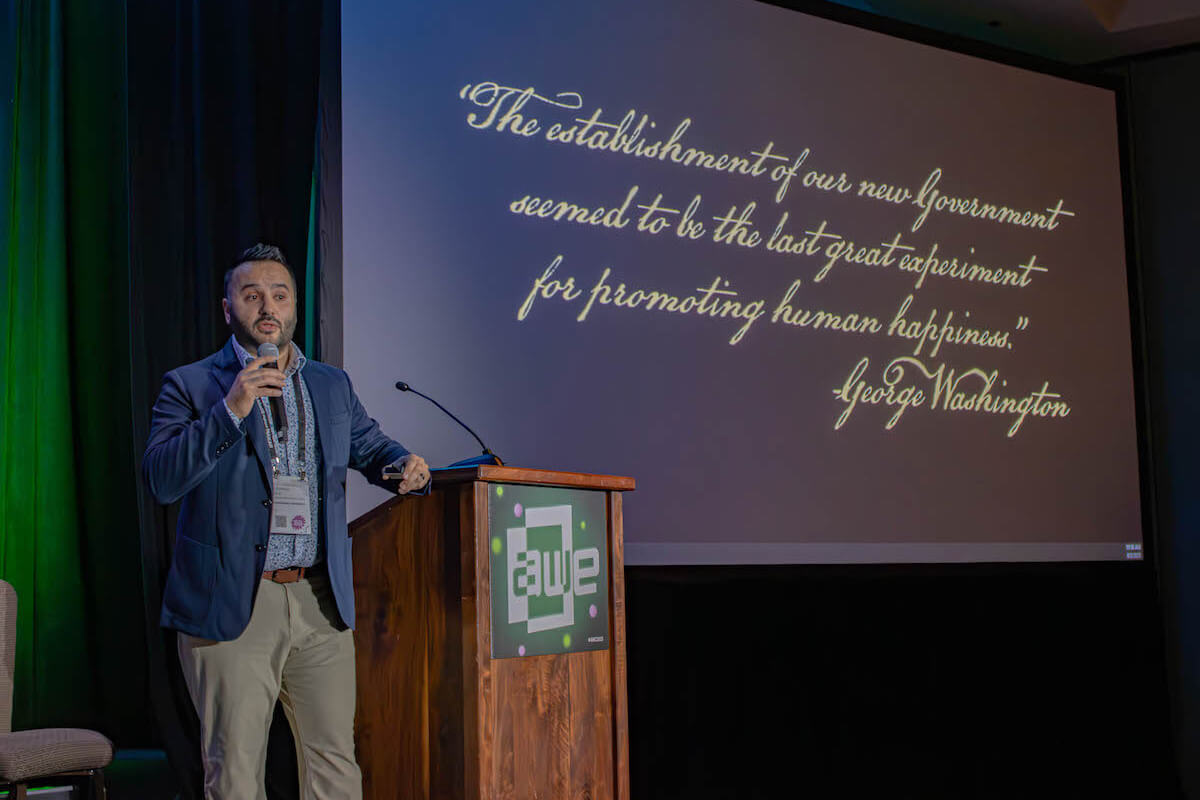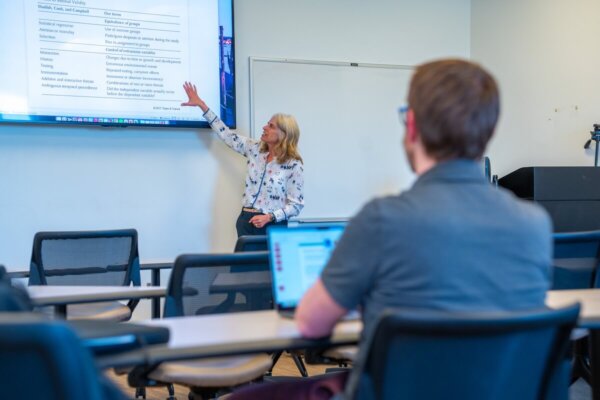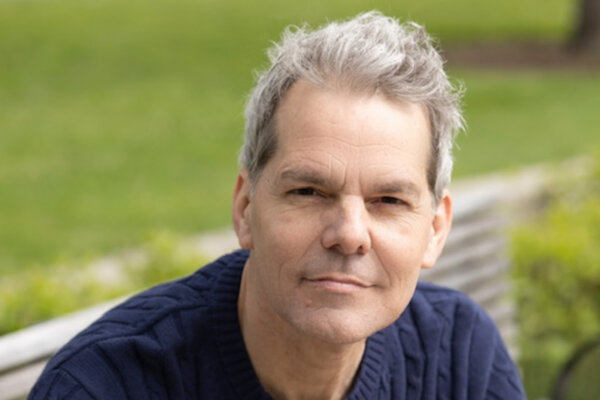Shenandoah University Represented At Prestigious Extended Reality Conference
Students, faculty presented info about history VR project at Augmented World Expo in California

Two Shenandoah University students and three faculty and staff members recently left the quiet, rolling hills of the Shenandoah Valley to immerse themselves in the high-tech terrain of the Silicon Valley and showcase SU’s work in augmented/virtual reality at one of the world’s top extended reality (XR) conferences.
 Shenandoah Director of Augmented Reality/Virtual Reality (B.S.) and Co-Director of the Shenandoah Center for Immersive Learning (SCiL) Mohammad Obeid, Ph.D.; Professor of History Warren Hofstra, Ph.D.; Amy Vaden, operations manager for SCiL, who managed all of the trip’s logistics; and SU students Gabrielle Pieklo ’26 and Luke Yager ’25 attended the Augmented World Expo (AWE) on May 31-June 2, in Santa Clara, California.
Shenandoah Director of Augmented Reality/Virtual Reality (B.S.) and Co-Director of the Shenandoah Center for Immersive Learning (SCiL) Mohammad Obeid, Ph.D.; Professor of History Warren Hofstra, Ph.D.; Amy Vaden, operations manager for SCiL, who managed all of the trip’s logistics; and SU students Gabrielle Pieklo ’26 and Luke Yager ’25 attended the Augmented World Expo (AWE) on May 31-June 2, in Santa Clara, California.
At the conference, Dr. Obeid and Dr. Hofstra – along with colleague Kevin Hardwick, Ph.D., a history professor at James Madison University – presented information about “The Great Experiment,” a VR program being developed at Shenandoah that takes users back in time to the Constitutional Convention of 1787. “The Great Experiment,” on which work began in 2020, is a collaborative effort between the history and virtual reality design programs at Shenandoah, the SCiL Lab, and others within and outside the university.
The leadership team behind the development of “The Great Experiment” includes Obeid, Hofstra, Dr. Hardwick and J.J. Ruscella, chief immersive officer at AccessVR and a former Shenandoah faculty member.
Those involved with the project have previously presented and demonstrated “The Great Experiment” at the annual meeting of the Organization of American Historians in Boston, at the Virginia Forum in Richmond, and at the American Philosophical Society in Philadelphia last year.
 In addition to the presentation by faculty at AWE, the team staffed a booth in the Expo Hall throughout the conference that represented SU and demonstrated various AR/VR projects built by Shenandoah students and faculty. Shenandoah was one of only three universities among the hundreds of exhibitors that included household names such as Amazon, Meta and Sony.
In addition to the presentation by faculty at AWE, the team staffed a booth in the Expo Hall throughout the conference that represented SU and demonstrated various AR/VR projects built by Shenandoah students and faculty. Shenandoah was one of only three universities among the hundreds of exhibitors that included household names such as Amazon, Meta and Sony.
Obeid said AWE, which hosts major conferences and exhibitions each year in the U.S., Europe and Asia, is the world’s largest XR conference. According to its website, this year’s expo in California drew over 5,000 attendees, more than 300 exhibitors and over 400 speakers.
This invitation to present at AWE highlights the level of innovation of this project and its contribution to the fields of AR/VR. It places the team, this work, and Shenandoah University on a larger, national spectacle. It was wonderful to observe the work of our students highlighted with considerable interest, with all its implications for education, intellectual life, and political behavior today. It was also noticeable that the work created by our students is of similar – if not exceeding – caliber as other works presented by our neighboring booths on the Expo floor.”
Mohammad Obeid, Ph.D., Shenandoah University Director of Augmented Reality/Virtual Reality (B.S.) and Co-Director of SCiL
 Hofstra said he too was struck by the enthusiastic reception that “The Great Experiment” received at the expo and by the encouragement offered by many of the attendees who experienced it. The potential impact of the project is “considerable,” Hofstra added.
Hofstra said he too was struck by the enthusiastic reception that “The Great Experiment” received at the expo and by the encouragement offered by many of the attendees who experienced it. The potential impact of the project is “considerable,” Hofstra added.
“The immersive technology community has been brilliant in creating new games, training sequences, and scenarios for children, but expanded subject matter for academic scholarship, university seminars, museum exhibitions, and K-12 education is much needed,” Hofstra said. “The message I heard in California was that ‘The Great Experiment’ goes a long way in filling this gap with content worth testing at colleges and universities, and worth applying across the spectrum of education and popular culture.”
Pieklo and Yager staffed the booth throughout the three-day conference to demonstrate “The Great Experiment” and other work Shenandoah has performed in the field of AR/VR.
To witness our exhibit attracting attention among the giants of Silicon Valley was inspiring. To see our students among the thought leaders and tech wizards of their field and watch them share their excitement for what the university is accomplishing in the lightning-fast field of immersive technology was truly thrilling.”
Warren Hofstra, Ph.D., Shenandoah University history professor
Yager, a virtual reality design student, said he appreciated the opportunity to see and use industry-level technology and network with professionals.
“Talking with representatives from each company allowed me to get a better understanding of how things functioned, both on the tech level and business level,” Yager said. “I had the opportunity to network with several companies and had great conversations about what specific field I may want to go into after college. Overall it was an amazing experience and I am very glad I had the opportunity to go!”
 Pieklo, who is studying media and communication, got to experience AWE from a different perspective than Yager.
Pieklo, who is studying media and communication, got to experience AWE from a different perspective than Yager.
“I am so grateful for the opportunity to go on this trip. I enjoyed connecting with so many creative people and learning about advancing technology,” Pieklo said. “The experience was more than just a technology conference. My favorite part outside of the conference was the night we hiked at an overlook and watched the sunset. The views were amazing and the hills are nothing like the mountains on the East Coast.”
The leadership team for “The Great Experiment” intends to continue showcasing the project at other events and venues, and the final virtual reality experience will be made available to the wider public.





